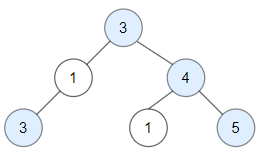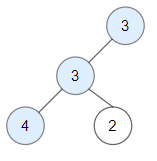LeetCode - Medium - 1448. Count Good Nodes in Binary Tree
Topic
- Tree
- Depth-first Search
Description
https://leetcode.com/problems/count-good-nodes-in-binary-tree/
Given a binary tree root, a node X in the tree is named good if in the path from root to X there are no nodes with a value greater than X.
Return the number of good nodes in the binary tree.
Example 1:

Input: root = [3,1,4,3,null,1,5]Output: 4Explanation: Nodes in blue are good.Root Node (3) is always a good node.Node 4 -> (3,4) is the maximum value in the path starting from the root.Node 5 -> (3,4,5) is the maximum value in the pathNode 3 -> (3,1,3) is the maximum value in the path.
Example 2:

Input: root = [3,3,null,4,2]Output: 3Explanation: Node 2 -> (3, 3, 2) is not good, because "3" is higher than it.
Example 3:
Input: root = [1]Output: 1Explanation: Root is considered as good.
Constraints:
- The number of nodes in the binary tree is in the range [ 1 , 1 0 5 ] [1, 10^5] [1,105].
- Each node’s value is between [ − 1 0 4 , 1 0 4 ] [-10^4, 10^4] [−104,104].
Analysis
方法一:递归版DFS
方法二:迭代版DFS
Submission
import java.util.LinkedList;import com.lun.util.BinaryTree.TreeNode;public class CountGoodNodesInBinaryTree {//方法一:递归版public int goodNodes(TreeNode root) {return goodNodes(root, Integer.MIN_VALUE);}public int goodNodes(TreeNode node, int max) {if(node == null) return 0;int nextMax = Math.max(max, node.val);return (node.val >= max ? 1 : 0) + goodNodes(node.left, nextMax)//+ goodNodes(node.right, nextMax);}//方法二:迭代版public int goodNodes2(TreeNode root) {if(root == null)return 0;int result = 0;LinkedList<Object[]> stack = new LinkedList<>();stack.add(new Object[] { root, Integer.MIN_VALUE});while(!stack.isEmpty()) {Object[] arr = stack.pop();TreeNode node = (TreeNode)arr[0];int max = (int)arr[1];if(node.val >= max)result++;int nextMax = Math.max(max, node.val);if(node.right != null)stack.push(new Object[] { node.right, nextMax});if(node.left != null)stack.push(new Object[] { node.left, nextMax});}return result;}}
Test
import static org.junit.Assert.*;import org.junit.Test;import com.lun.util.BinaryTree;public class CountGoodNodesInBinaryTreeTest {@Testpublic void test() {CountGoodNodesInBinaryTree obj = new CountGoodNodesInBinaryTree();assertEquals(4, obj.goodNodes(BinaryTree.integers2BinaryTree(3, 1, 4, 3, null, 1, 5)));assertEquals(3, obj.goodNodes(BinaryTree.integers2BinaryTree(3, 3, null, 4, 2)));assertEquals(1, obj.goodNodes(BinaryTree.integers2BinaryTree(1)));}@Testpublic void test2() {CountGoodNodesInBinaryTree obj = new CountGoodNodesInBinaryTree();assertEquals(4, obj.goodNodes2(BinaryTree.integers2BinaryTree(3, 1, 4, 3, null, 1, 5)));assertEquals(3, obj.goodNodes2(BinaryTree.integers2BinaryTree(3, 3, null, 4, 2)));assertEquals(1, obj.goodNodes2(BinaryTree.integers2BinaryTree(1)));}}



































还没有评论,来说两句吧...